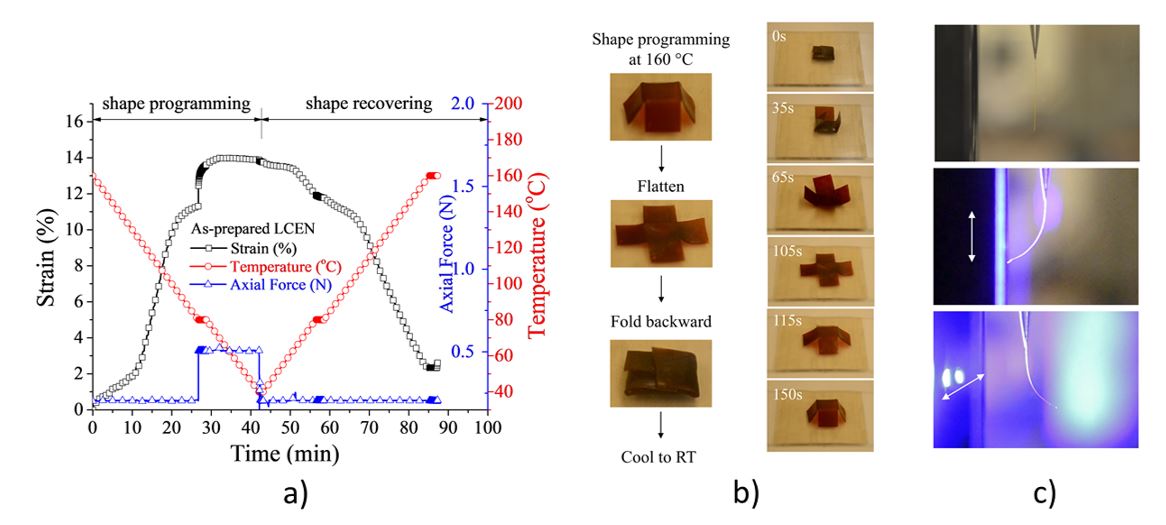Video Article Open Access
Advances in Multifunctional Liquid Crystalline Networks
Michael R. Kessler1,*, Yuzhan Li2, Yuehong Zhang3, Orlando Rios2
1College of Engineering, North Dakota State University, Fargo, ND, 58108, USA
2Materials Science and Technology Division, Oak Ridge National Laboratory, Oak Ridge, TN, 37831, USA
3School of Mechanical and Materials Engineering, Washington State University, Pullman, WA, 99164, USA
Vid. Proc. Adv. Mater., Volume 2, Article ID 2021-0192 (2021)
DOI: 10.5185/vpoam.2021.0192
Publication Date (Web): 19 Feb 2021
Copyright © IAAM
Graphical Abstract

Abstract
Liquid crystalline networks (LCNs) are versatile functional materials because of the unique properties of liquid crystalline molecules, e.g., self-organization, reversible phase transition, and macroscopic orientation under external fields. The coupling between LC molecules and polymer networks allows these remarkable properties to be transferred to the bulk material and has resulted in a number of functional LCNs that are thermally-responsive and can change their shape reversibly due to the reversible LC phase transition upon temperature cycling. In this lecture, we show how the incorporation of photo-responsive chromophores into LCNs allows the material to convert light energy into mechanical work because of the transformation between two geometrically different isomers upon light irradiation. We demonstrate a simple route to incorporate three functional building blocks, including chromophores, liquid crystals, and dynamic covalent bonds, together into a liquid crystalline network. The three functionalities show good compatibility and the resulting material can exhibit various photomechanical responses, dual-stimuli induced shape memory and self-healing properties, and excellent processability and recyclability.
Keywords
Liquid Crystal Networks; Multifunctional; Shape Memory.
Acknowledgement
Some of this work was supported by the Air Force Office of Scientific Research (Award FA-9550-12-1-0108). Technical contributions from J. K. Keum, M. Goswami, D. Vincent, and L. Wang are also gratefully recognized.
References
- Y. Li, Y. Zhang, O. Rios, J. K. Keum, M. R. Kessler, Soft Matter, 2017, 13, 5021.
- Y. Li, Y. Zhang, O. Rios, J. K. Keum, M. R. Kessler, RSC Advances, 2017, 7, 37248.
- Y. Li, Y. Zhang, M. Goswami, D. Vincent, L. Wang, T. Liu, K. Li, J. K. Keum, Z. Gao, S. Ozcan, K. R. Fluesenkamp, O. Rios, M. R. Kessler, Soft Matter, 2020, 16, 1760.
Biography
Michael R. Kessler is the Dean of the College of Engineering and Professor of Mechanical Engineering at North Dakota State University. Before his role as Dean, he served as the Berry Family Director and Professor of the School of Mechanical and Materials Engineering at Washington State University from 2013-2017. He was the founding co-director of the Center for Bioplastics and Biocomposites (CB2), a National Science Foundation (NSF) Industry and University Cooperative Research Center (I/UCRC) that focuses on developing high-value biobased products from agricultural and forestry feedstocks and sponsored by about 30 member companies and the NSF. Prior to joining the faculty at Washington State University in August 2013, he held faculty positions at Iowa State University, where he was most recently the Wilkinson Professor in Interdisciplinary Engineering, and the University of Tulsa. He obtained his Ph.D. (2002) in Theoretical and Applied Mechanics from the University of Illinois at Urbana-Champaign. His research and teaching interests are in the mechanics, processing, and characterization of multifunctional polymer matrix composites, nanocomposites, and bio-based polymers. His honors include Young Investigator Awards from the Army Research Office and the Air Force Office of Scientific Research, an NSF CAREER award, and the Elsevier Young Composites Researcher Award from the American Society for Composites. He has over 260 peer reviewed journal papers and conference proceedings with 15,000 citations, holds 20 issued US patents, edited 14 books, presented over 200 talks at national and international meetings, and serves as a frequent reviewer and referee in his field. He is the past president of the North American Thermal Analysis Society (NATAS) and a Fellow of the American Society of Mechanical Engineers, ASM International, and NATAS, and a Kavli Fellow of the National Academy of Sciences.
Video Proceedings of Advanced Materials

Upcoming Congress



